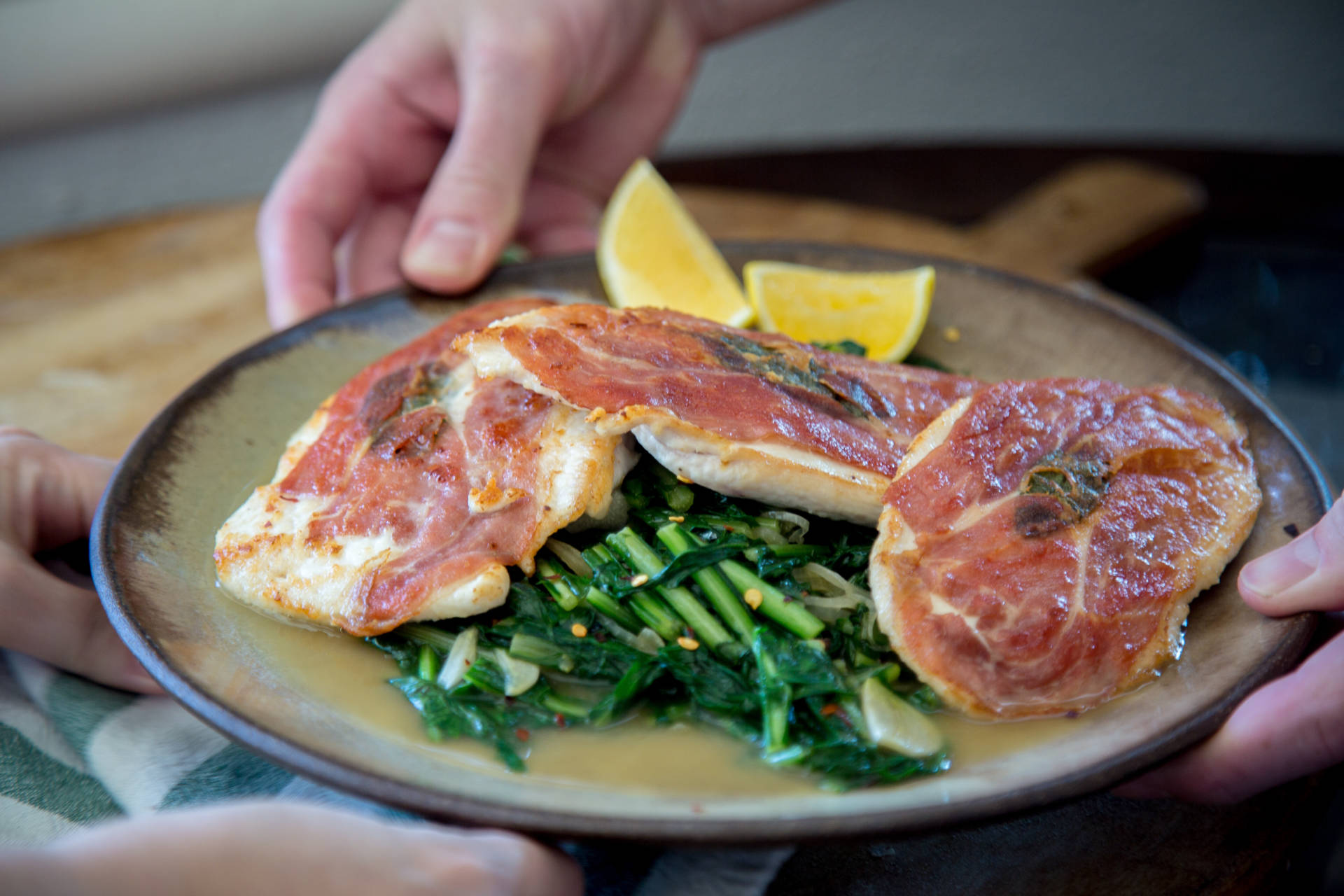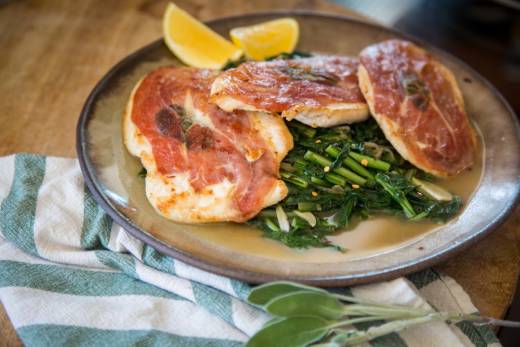Tradition seems to demand that any respectable Thanksgiving meal revolve around a monumental roast turkey. I must dissent! Conventional turkeys have been bred to be massive and exceedingly lean, which means they easily dry out after long roasting times. As I see it, turkey needs all the help it can get—a contentious opinion at the best of times, it becomes downright blasphemous during the holidays.
But before I paint myself as some sort of Thanksgiving Scrooge, allow me to backpedal. I, like any holiday hedonist worth their salt, adore the crispy skin of an expertly roasted turkey — it’s almost worth the price of admission. So how to reconcile my general indifference to turkey with my desire for that crispy payoff?
My answer lies in taking an unconventional route: using lean turkey breast in a Roman dish called saltimbocca (“jumps in the mouth”), which features thinly pounded cutlets, sage, and prosciutto. The sage makes these fragrant — and seasonally appropriate — but it’s the prosciutto that makes them luscious. After pan-frying, the salty ham becomes crispy, and it mimics that all-important crispy skin while keeping the turkey tender and juicy.
It’s the perfect solution for anyone who wants more out of their turkey experience, without the hassle and wait of a giant bird; especially in the case of smaller, more intimate Thanksgiving meals.
Turkey Saltimbocca with Braised Escarole
Makes 4-6 servings

Ingredients:
- 1 medium boneless skinless turkey breast, about 2½ pounds
- 6 fresh sage leaves
- 2 ounces thinly sliced prosciutto, about 6-12 slices
- Salt and freshly ground black pepper
- ¼ cup all-purpose flour
- 3-4 tbsp olive oil
- 3 tbsp unsalted butter
- 1 shallot, thinly sliced
- 3 cloves garlic, thinly sliced
- Pinch red pepper flakes
- ¾ cup of dry vermouth or dry white wine
- 1 cup low sodium turkey or chicken stock
- 1 large bunch escarole or other bitter green, washed and cut into 1” pieces
- 1 lemon, preferably Meyer, cut into 6 wedges
Instructions:
- Cut the turkey breast into cutlets: using a sharp knife, slice the turkey at a 45º angle against the grain, to make 6 cutlets of approximately equal size, no more than ¾ inches thick.
- Line a work surface with a sheet of plastic wrap large enough to fit 1 or 2 cutlets with several inches of space around each. Place a sage leaf on the center of each cutlet, then lay a slice or two of prosciutto on top, enough to completely cover the cutlet with a bit of overhang at the edges. Cover the cutlets with a second sheet of plastic wrap, and, using a meat mallet or heavy rolling pin, gently but firmly pound the cutlets until they’re approximately ¼ inch thick and their surface area has almost double. Repeat with the remaining cutlets.
- Season each cutlet with salt and pepper on the side without prosciutto, then dust both sides with flour to completely coat, shaking off any excess.
- Heat a large skillet or sauté pan over medium-high heat. Add 2 tablespoons of the olive oil, and when it shimmers and gives off wisps of smoke, place the cutlets, prosciutto side down, into the pan without overlapping. Unless you have a very large pan, you will likely have to sear in two or three batches; add additional olive oil to the pan as needed.
- Use a spatula to press down on the cutlets, to ensure they make full contact with the pan, and sear for 3-5 minutes, until the prosciutto is crisp and deep golden brown, rotating the cutlets as needed so that they brown evenly. Flip the cutlets and cook about 1 minute more, until the turkey side begins to color and the cutlets are completely cooked through. Transfer the cooked cutlets to a sheet, prosciutto side up, and repeat with remaining cutlets. Once all the cutlets are cooked, keep them warm in a low oven or wrap them lightly with aluminum foil.
- Return the pan to medium-high heat, add 1 tablespoon of the olive oil and 2 tablespoons of the butter, and swirl until the butter has foamed and begun to brown (if your pan is still very hot, this will happen quickly). Add the shallot, followed by the garlic, and cook, stirring frequently, until translucent and beginning to brown, about 2-3 minutes. Season with a generous pinch of salt and red pepper flake and cook 30 seconds more. Add vermouth, which should boil immediately, using a wooden spoon to scrape up any brown bits stuck to the pan.
- Let the vermouth boil until reduced by half, about 1-2 minutes, then add the chicken stock. Return to a boil and cook for 1 minute more before adding the escarole, seasoning with salt as you add it to the pan. Cook, tossing and stirring, until the escarole has wilted down into the pan, about 2-3 minutes.
- Remove from heat, swirl in the remaining tablespoon of butter, and season to taste with additional salt and pepper.
- Spoon the escarole onto a warm serving platter, along with the pan juices. Arrange the cutlets on top and serve with lemon wedges, to be squeezed over the cutlets by your guests.
